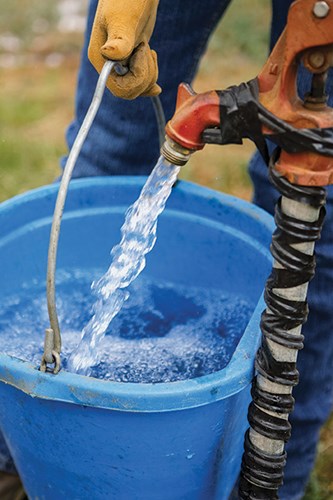Just because you’re mounted up doesn’t mean that your horse should charge ahead at full speed. If you want to take a break from your trail ride and choose not to dismount, your horse should willingly stand still until you give a cue to move.

If your horse is “jiggy” or anxious to get moving on the trail, he probably won’t stand still and chill out when you’d like a break.
For help teaching your horse to stand still when you’re in the saddle, keep reading. For help with your horse’s jiggy behavior from Goodnight, click here.
Goodnight sees antsy, fidgety behavior in almost all her clinics. She often asks riders to stop their horses on the rail after trotting for a bit. This seemingly simple request proves difficult for some.
Many horses learn that once they’re moving, they should keep moving. They feel their rider’s tension, feel rein pressure, and think they’re receiving a cue to “go, go, go!”
If your horse stands for a split second, then begins to paw and tense, preparing to move, you might find yourself circling him to keep him from moving forward. Here, I’ll tell you the cause of this behavior, then give you an easy fix.
The Cause
A horse’s antsy mount-up behavior may exist because he’s never learned to stand quietly and politely. More often, the rider is contributing to or causing the problem.
Inadvertently, you’ve likely trained your horse that before you ask him to do something (such as go faster), you’ll shorten up the reins and come to attention in the saddle. This becomes his pre-signal that you’re getting ready to ask him something, so he prepares for action.
On the other hand, you likely have also taught your horse that when you don’t want him to do anything, you’ll loosen the reins, relax in your body, and take your focus off of him. That’s when he knows it’s okay to put his head down and relax.
When Goodnight sees a fidgety horse, the rider has likely stopped her horse, but then has failed to release the reins and relax her posture. Instead, she’s tilted forward with a short grip on the reins—which is the “be prepared for action” position for her horse.
Easy Fix
Ask your horse to stop and stand. Then loosen the reins all the way, lay your hand on his neck, and relax your body. If he makes any unauthorized movement, pick up the reins, pull him abruptly to a stop, then completely release the reins again.
With consistent reinforcement, your horse will learn to stand quietly in all situations.
For more information on equine behavior, see Goodnight’s Guide to Great Trail Riding, with bonus DVD, available from www.equinenetworkstore.com.
Julie Goodnight (www.juliegoodnight.com) lives in central Colorado, home to miles of scenic trails. She trains horses and coaches horse owners to be ready for any event, on the trail or in the performance arena. She shares her easy-to-understand lessons on her weekly RFD-TV show, Horse Master, and through appearances at clinics and horse expos held throughout the United States. She’s also the international spokesperson for the Certified Horsemanship Association (www.cha-ahse.org).






